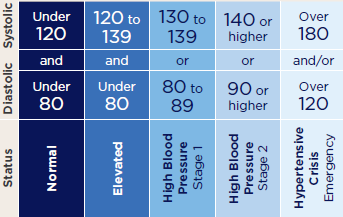Blood pressure is the pressure that your blood puts on the walls of your arteries. An artery is a blood vessel (tube) that carries blood from your heart to the rest of your body.
High blood pressure is also called hypertension. It’s when the force of your blood pressing against your artery walls is too high. High blood pressure usually has no symptoms. You may not know you have it until your blood pressure is tested.
It’s important to have your blood pressure checked because high blood pressure can cause problems, such as:
- Damage to your heart.
- Stroke.
- Vision loss.
- Kidney disease.
- Erectile dysfunction (problems getting hard for sex).
Understanding the Numbers
Blood pressure is measured and written as one number over another.

The top number is your systolic blood pressure. It measures how much pressure your blood puts on your artery walls when your heart beats.
The bottom number is your diastolic blood pressure. It measures how much pressure your blood is putting on your artery walls when your heart rests between beats.
One or both of these numbers can be too high. If they’re too high, you may have hypertension. The chart below shows the ranges for healthy and unhealthy blood pressure levels.

Figure 1. Chart to help you understand blood pressure.
Know Your Risk
Certain things increase a person’s chances of having high blood pressure. These things are called risk factors. There are some risk factors that you can’t do anything about. For example, you may have family related to you by blood who have high blood pressure. If so, you’re more likely to have it, too. Your risk for high blood pressure also increases as you get older.
Your race and ethnicity cam also affect your risk for high blood pressure. For example, if you’re African American, you’re more likely to develop high blood pressure. You’re also likely to get it younger than people from other racial and ethnic backgrounds.
Make Healthy Habits
Eat a healthy diet. Include lots of fruits and vegetables, low-fat dairy products, and fiber.
- Do not eat foods high in fat, such as fatty cuts of meat (pork belly), solid fats (lard or margarine), fried foods, or sweets (such as desserts and candy).
- Limit the amount of caffeine you eat and drink. Remember that caffeine is also found in some foods like dark chocolate and drinks, such as tea and soda.
- Eat foods low in sodium (salt). Most people should eat less than 2 grams of sodium a day. Talk with your healthcare provider about the amount that’s right for you.
- Eat more foods with potassium. Potassium is found in foods such as bananas, potatoes, beans, and yogurt.
Lose weight, if you’re overweight.
Do something active for 30 minutes a day, 5 days a week. You can do it all at once, such as a 30 minute bike ride. Or, you can break it up, such as 10 minutes of dancing, or walking 3 times in a day.
Don’t drink more than 1 alcoholic drink a day if you’re female. Don’t drink more than 2 drinks a day if you’re male. One drink can be a can of beer, a glass of wine, or a shot of liquor. If you’re transgender and have questions, talk to your healthcare provider.
Quit or cut down how much you smoke. For help, call the NY Quitline at 866-697-8487.
Talk with Your Healthcare Provider
Sometimes making healthy choices is not enough to keep blood pressure under control. Remember to have your blood pressure checked regularly. Talk with your doctor about whether medicines are right for you.
More Resources
How to Prevent High Blood Pressure
www.medlineplus.gov/howtopreventhighbloodpressure.html
Prevención de la presión arterial alta
www.medlineplus.gov/spanish/howtopreventhighbloodpressure.html
